Top 13 Software Development Models — Which is best? | Scopic
Recently Updated on December 28th, 2022.
Software development life cycle (SDLC) models define the flow of software building projects.
SDLC methodologies give you a specific structure to follow while executing each step of the process including planning, analysis, designing, developing, coding, testing, deploying, and maintenance.
That’s why choosing the right SDLC type for your unique needs can make or break your software project, affecting its quality, timeframe, and budget.
But with so many various SDLC methods, you need to have a deeper understanding of their characteristics and use cases.
To help you understand which models you can adopt to launch your projects to success, we’ll cover 13 of the best software development models, their pros, cons, and practical uses.
Table of Contents
Fail to structure your project right and you risk falling into the 52.7% of projects that cost 189% of their original estimates. But developing your dream ideas into reality doesn’t have to accrue unnecessary costs — or drag on into an abyss of never-ending stress.
Thanks to masterminds like Dr. Winston W.Royce, or Jeff Sutherland and co; software development models such as Waterfall and Agile have made the development process much more efficient.
With numerous methodologies at your disposal, it is now much easier for growing businesses to build upon innovative ideas.
Starting out on the road of innovation, however, requires a deeper understanding of your options. This will help you weigh up your needs against the pros and cons of the best SDLC methods.
To make an informed decision about the right software development model for your unique project, you first need to know which methodologies are worth considering.
Once you have a clearer idea of what each SDLC model is — as well as the types of projects they are most suitable for — you can then evaluate what’s most compatible with your vision and objectives.
Before jumping headfirst into the most commonly used software development methods for growing companies though, let’s start by defining what this term means.
Mục lục bài viết
What are SDLC Models?
Software development life cycle models (or SDLC models for short) are essentially methodologies that improve the workflow and outcomes of your software project.
The ultimate goal: more effective processes to ensure higher project success rates.
According to the academics Fitzgerald and Friedman, ‘’the move to the SDLC approach represented a shift towards tighter control of the development process’’.
With tighter control, comes increased efficiency. With increased efficiency comes higher-quality solutions delivered in less time. What does this ultimately mean for your project? More bang for your buck! More success and more luck!
There are dozens of variations — from waterfall to agile, spiral to V model, and everything in between. The one thing they all share in common? Each type of SDLC model can generally be broken down into six phases:
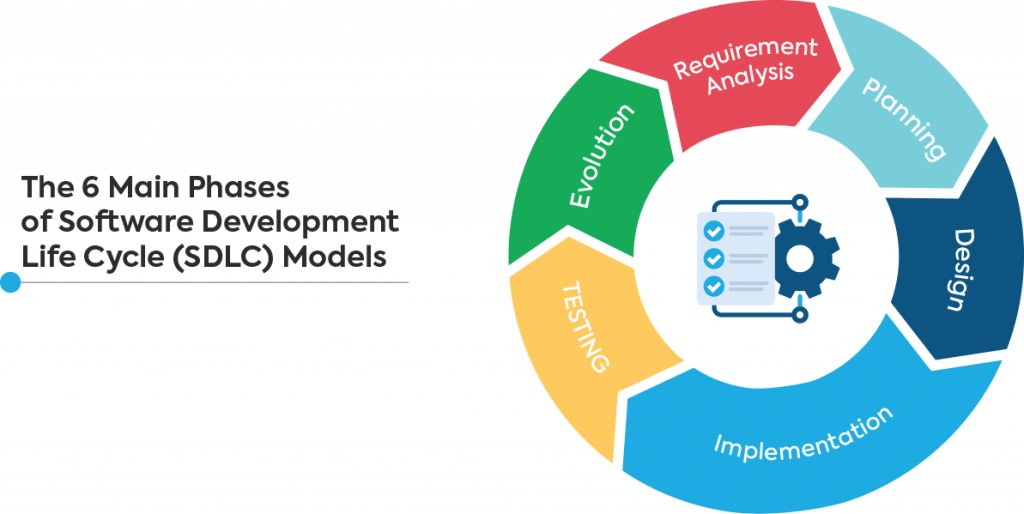
Each model in software engineering has its advantages and disadvantages.
The long list of options grows every year as ‘‘the faster metabolism of business today’’ demands for more efficient processes and speedier turn-around times. Project management experts and developers will analyze the scope, software requirements, budget, and business goals before deciding upon the software development model that’s right for you.
With plenty to choose from, let’s start by looking at the top software development methodologies our experts recommend.
Our Four Favorite Software Development Methodologies — Ideal for Growing Companies
At Scopic, our client projects range in size, budget, and requirements. Yet for 90% of the projects, we work on, these four types of SDLC models shine through as the best fit for our clients’ needs. .
Waterfall Model
Waterfall is the mother of all SDLC models. Established in the 70s, it was the first methodology to transform the way systems are built. This model follows a strict structure.

Documentation plays a key role in the waterfall SDLC. At every stage of the development process, there are deliverables. Work cannot begin on a new stage until the previous phase is complete, so the process is linear and easy to manage. Waterfall has been subject to heavy criticism in recent years for being too rigid and outdated. However, there are still numerous benefits of adopting this methodology when working on the first version of a product.
Advantages
-
Easier to stick within a predefined budget or timeline
-
Relatively straightforward for
management
-
Simple to measure and monitor progress with deliverables at every stage
-
Very organized and transparent. Heavy documentation and initial planning add clarity and reduce the risk of miscommunication
-
Possible to identify and eliminate potential errors when planning. This can save time during
integration
-
New developers can join the project at any time because technical documentation is thorough
Disadvantages
-
A very rigid structure can be restrictive — each stage is dependent on the previous one
-
Not possible to revisit requirements after the first stage of the development cycle
-
The bigger the project, the more difficult it is to predict all
software requirements
in the first stage
-
Testing and deployment don’t take place until the final stages. The risk of encountering unanticipated errors is, therefore, quite high.
-
Mistakes are expensive to resolve and can negatively impact the predicted timeline
Ideal Use Cases
- Small to medium-sized projects
- Products that have strict demands and clear rules to adhere to, for example in the healthcare and aviation industries.
- Any project with a strict budget or tight deadline to meet
- Startups or small companies who are looking for high-quality simple solutions on a budget
- Business owners who want to follow an organized structure without being too heavily involved
Scopic Reflections
At Scopic, we often use this methodology with small and mid-sized projects that are not big enough to be split into sprints.
This software development model is also ideal when building a new product from scratch. The strict structure makes it easier to meet expectations while sticking within a set budget and time-frame. Planning is thorough and the scope of work is laid out clearly from the get-go. Once the initial prototype has been launched and more flexibility is required, we then often recommend migrating to a more agile approach.
We wouldn’t suggest Waterfall for larger projects of more than 2,000 hours as these are often subject to change along the way. This more traditional model is too rigid to anticipate all the complexities of a big project. Any deviation from the original plan would be costly and cause delays.
Incremental and Iterative Model
Inspired by Waterfall, the Iterative and Incremental software development models allow more room for iterations and testing throughout the process.

Unlike Waterfall, in both the Iterative and Incremental software engineering models, it is not necessary to plan the whole project management upfront.
Instead, you can split the process into four main stages.
Each stage can be planned in full, then designed, developed, and delivered before moving onto the planning for the next phase. Testing also plays a more prominent role during the design and development stages. With the Iterative and Incremental models, each iteration can be completed in parallel with one another or sequentially. Software changes can be implemented at any time. The main difference is that in Iterative, each iteration has a knock-on effect so that the software design and development is constantly progressing and improving.
Advantages
-
Provided they are small, modifications can be made at any stage throughout the process
-
Increased flexibility — not all requirements have to be established in the first phase
-
Testing is performed at every stage so errors are easier to detect and fixes easier to implement
-
Very honest and transparent. You can negotiate pricing in phases and will have concrete deliverables to review every step of the way
-
Easy to gauge project progression without copious amounts of documentation needed
-
With less documentation, there is more time for design and development
-
Less risk involved. You can fund the first phase and perform
risk assessment
without having to commit to the whole project upfront
-
Easy to control and reach set milestones within the timeframe and budget set
-
Possible to test and implement valuable user feedback before the end product is finalized
Disadvantages
-
To avoid critical issues further down the line, all major requirements must still be outlined in the initial stage of the project
-
Making substantial modifications is costly and time-consuming to implement
-
Still not as flexible as an agile approach
-
Requires heavier
project management
-
Constant repetition of software cycles can impact overall costs and project timelines
Ideal Use Cases
-
Medium-large projects
-
Projects that have a controlled budget or timeline
-
Business owners who either can’t or don’t want to be heavily involved in the project
-
Entrepreneurs who are seeking funding for their project and want to show concrete deliverables at the end of each phase
-
Applications that have a large user-base and where
customer satisfaction
and feedback is vital
Scopic Reflections
Incremental and Iterative are our favorite types of software development models for medium-sized, first-time projects.
They allow for more flexibility than the Waterfall methodology, while still making it plausible to set and stick to a fixed budget.
If you’re looking for full transparency at every phase, this option is ideal. If a project is overly complex you can gauge how much work is involved after the first deliverable. This will give you a much clearer picture of the product possibilities and overall budget for the entire project.
You then have time to seek further funding, pool user feedback, or make more concrete decisions about the final product before moving forward. Due to the nature of the workflow, these software development models are not suitable for small projects that require less than 2,000 hours of work.
Agile Model
In 2017, 71% of the almost 4,000 organizations who were interviewed, reported using ‘‘agile approaches in their projects either sometimes or more frequently than in the past’’.
In a more recent Statista survey, 88% of the 1,091 technology professionals who were questioned, mentioned that they ‘‘had adopted an agile development methodology at their organization’’.
It’s safe to say that for many, agile is becoming the go-to formula to reach their software product goals! So what does agile mean in software development terms?
Formally brought to life in 2001, this type of software life cycle model is based on 4 core values and 12 principles. The ultimate goal: to better organize teams and make development projects more efficient.

There are several software development models that fall under the bracket of the agile approach.
All of which have three key things in common:
-
Teams
focus on short cycles, more commonly known as sprints. Each of these sprints lasts around 2-4 weeks long. Within this time, a team takes a fragment of the project and works on it from start through to completion. This contrasts with the more traditional, phase-driven methodologies, such as Waterfall and Incremental and Iterative.
-
Each team is small, independent, and self-sufficient. These
development
teams
are made up of 5-9 individuals. As a unit, they have all the skills-sets needed to get the work done without seeking help from other
teams
. The project manager’s involvement is minimal as developers are trained and trusted to do their best work.
-
With agile, the focus is not on planning and documentation. Instead, the approach allows for increased flexibility. It is also much more centered around testing. Frequent product releases allow
teams
to gain valuable user feedback from
early on in the
project workflow.
The 2020 State of Agile Report outlines five main reasons why companies and development teams are turning to agile methodologies.

Other benefits of using an agile approach include:
Advantages
-
Easy to improve software and fix issues as they occur
-
Not necessary to know or heavily plan all the project requirements in the very first phase — the product can be adapted to changing ideas and
specifications
-
Development work can be completed quickly and efficiently
-
Teams are self-organizing and independent
-
User feedback early on can provide valuable insights
-
Flexibility to adapt your
technology
solution, implement feedback, and resolve issues at any stage
-
New features can be added with ease
-
Easier to meet
customer satisfaction
and expectations because clients and users are more involved
Disadvantages
-
Difficult to set a budget. The project is subject to change so much that it is almost impossible to anticipate the overall costs
-
Hard to predict the time and resources needed from day one
-
Documentation and planning are still required but do not take precedence. This means if your team is not diligent enough, key
technique
documentation is often put on the back burner
-
High risk of creating a fragmented final product
-
With no concrete idea of what the end product will be like, the process can end up being forever ongoing
-
Difficult to set concrete KPIs at the beginning so measuring progress can be challenging
Ideal Use Cases
-
Large projects that are impossible to plan out to the very last detail
-
Projects with no well-defined ideas or plans in mind
-
Companies or individuals with a flexible budget
-
Products that have a large user-base or are in a competitive industry whereby listening to feedback can be make or break
Scopic Reflections
At Scopic, we recommend agile software engineering models when a project is too large to be broken into phases.
Sprints are ideal in this scenario. We also often suggest migrating to agile once the first idea has been developed. This helps keep costs down in the first version when an idea is new and the results are still unknown. It then allows room for more flexibility when developing the product further. That way, teams can visualize and unite the end business goals with the current variation.
By breaking down the scope of work on a more granular level, the team can also speed up development time and work more efficiently. We don’t recommend following an agile approach if you have a very tight budget or timeline to adhere to.
Agile Scrum Model
One of the most popular agile techniques (and one of our personal favorites) is Scrum.
Based on the foundations of agile software development models, this framework is more defined than other agile methodologies. With daily meetings and an experienced Scrum Master to oversee and report on the project progress, this branch of agile is ideal if you want to take a more collaborative, hands-on approach.

Advantages
-
Gives you the flexibility to change requirements as you go (much more so than other frameworks)
-
Easy to identify and overcome issues during the
coding phase
and other stages as they arise
-
Communication is at the heart of Scrum so expectations are much clearer and easier to reach
-
Feedback-centric so final outcomes will be of high-quality
-
Easy to prioritize key features and requirements
-
Simple to adopt from the very start
-
Frequent updates mean everyone involved stays on track of progress easily
Disadvantages
-
Numerous sprints can add significantly to project length
-
Difficult for cost
assessment
from the start
-
Only the most experienced software
technology
developers should be placed on a Scrum-led project
-
Daily meetings and reporting can be very time-consuming
-
Not suitable for smaller project
modeling
with tight budgets
Ideal Use Cases
-
Medium-sized projects
-
Companies or business owners who have at least a basic understanding of agile Scrum and have the time available to be heavily involved in
coding
,
delivery
, and
maintenance
-
Individuals who are looking to take some degree of ownership in their project
Scopic Reflections
Scrum is great if you already understand the framework to some degree. It is also ideal if you only have a basic idea that you want to explore further. However, this technique is heavily centered around communication and collaboration rather than efficiency. This means you will need to be very involved in the process at every stage of the project.
If you have a fixed budget to stick to, we wouldn’t recommend using Scrum.
Opening the Door to Hybrid Solutions — Why You Should Consider Methodology Migration
As you can see, even the most popular software models and planning techniques have their drawbacks.
Like anything worth fighting for, software product development is complex. There is no such thing as the perfect custom software solution. Different software projects come with different complexities. Every methodology with its own restrictions.
The path towards success is often windy and there’s no one simple answer. Dr. Kneuper predicted that firms need to develop hybrid SDLCs that adopt the best practices of both plan-based and agile software development models. In some cases, it may even be worth considering beginning with one methodology and then switching to another later.
This is known as methodology migration. According to PMI’s global survey, one in five projects use these hybrid or blended approaches to increase efficiency and success rates. 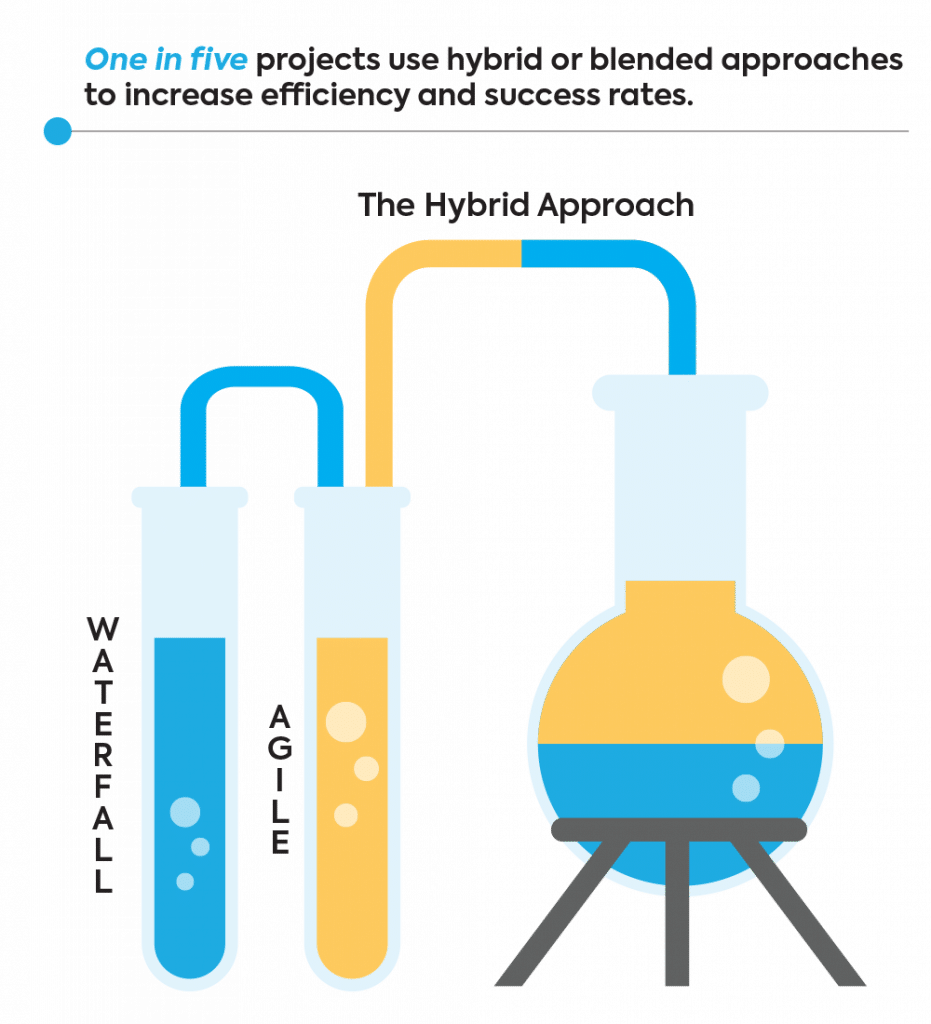 At Scopic, we find that for some projects it makes the most sense to begin with the waterfall model for the first version of the software.
At Scopic, we find that for some projects it makes the most sense to begin with the waterfall model for the first version of the software.
This gives our more budget-sensitive clients better control of the costs and timeline. Once their product has been released, we can then start working on version 2.0 by migrating to more flexible agile methods.
Working in sprints allows us to add new features and make improvements in a much more dynamic way.
Before deciding which approach is right for your specific project, make sure you’ve read up on your options well. There are a handful more types of software development models for you to choose from. Here’s a quick look at some other common alternatives:
Spiral Model
The spiral software design model pays special attention to risk assessment. Inspired by the Incremental and Iterative software development life cycle models, it is repetitive by nature. Each spiral is made up of four key phases — planning, risk assessment, development, and evaluation. When one full cycle is complete, the spiral continues, building on from the previous outcomes. 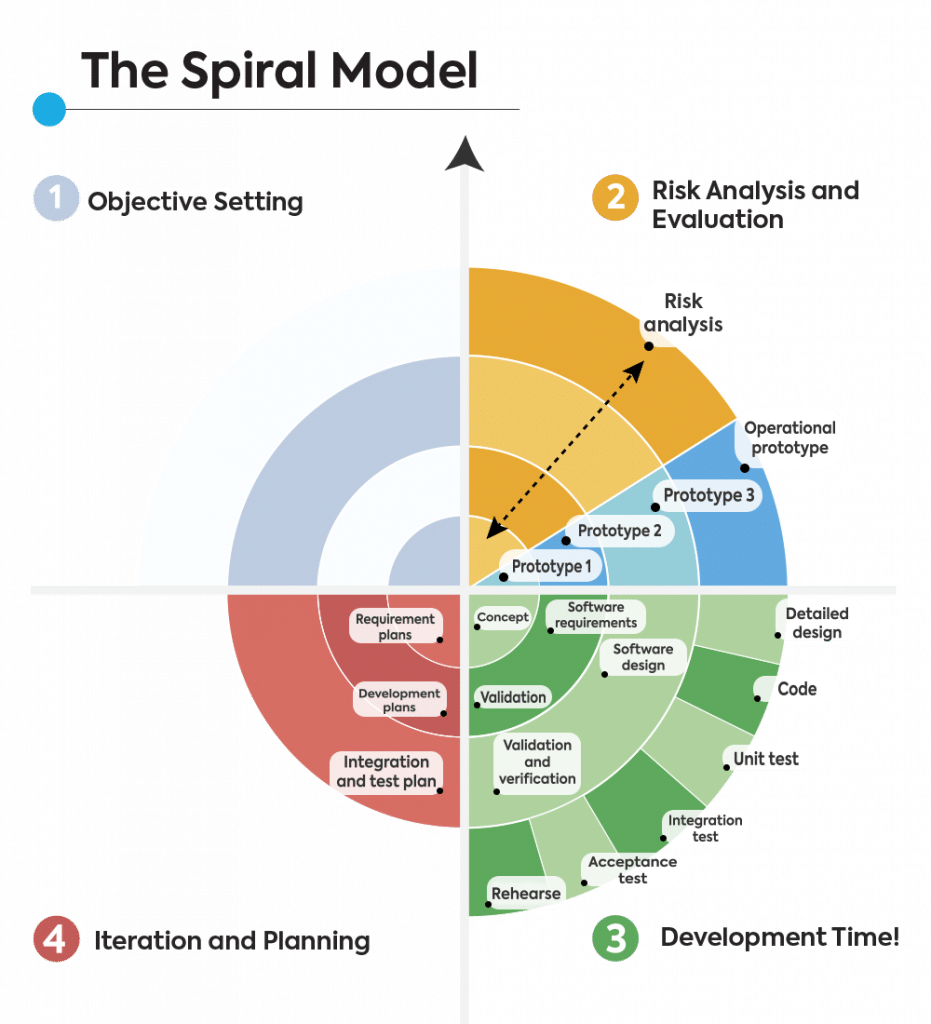 This model is ideal for large, high-risk projects that are mission-critical. However, it can be costly and time-consuming. Because of this, we wouldn’t recommend this methodology for small and medium-sized projects.
This model is ideal for large, high-risk projects that are mission-critical. However, it can be costly and time-consuming. Because of this, we wouldn’t recommend this methodology for small and medium-sized projects.
Inspired by Waterfall, the V-model technique (otherwise known as the Verification and Validation model), is a linear methodology.
Sequential by nature, you need to know all requirements from the beginning. Once a phase is complete, returning to it is very challenging and expensive.
This model is well-known for its thorough testing at every development stage. Because of this, quality assurance is a major advantage. On the other hand, it makes the sequential flow very time-consuming and costly, especially if any errors are found. 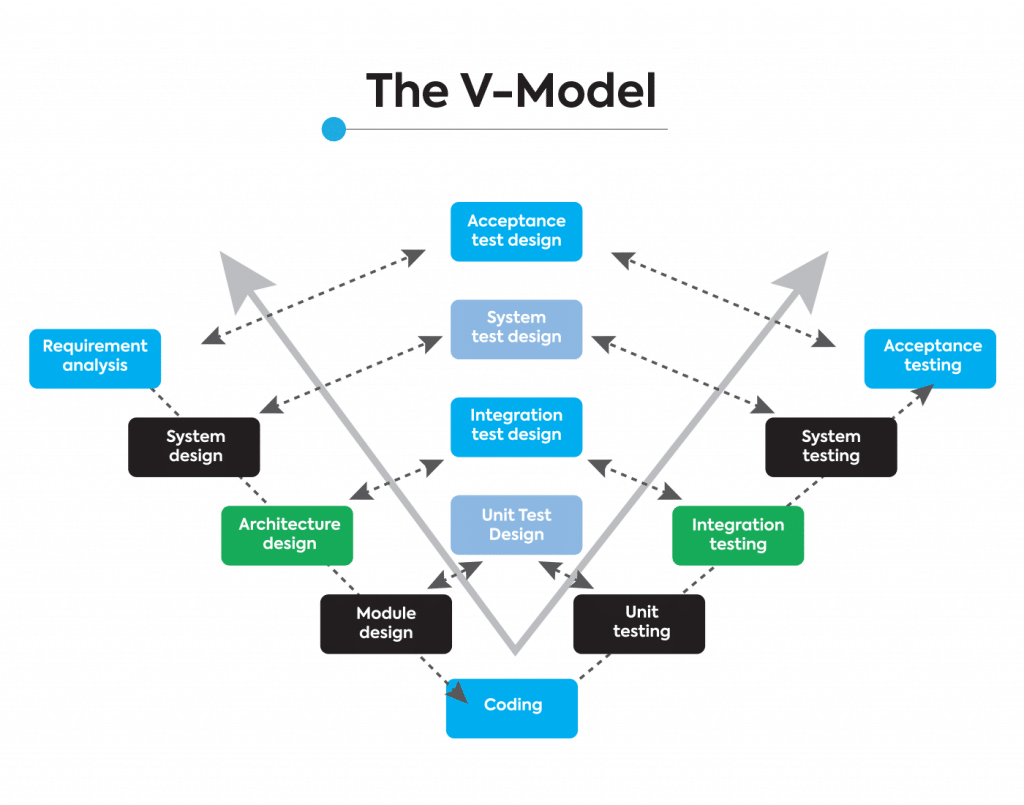
The scrupulous development and testing process makes the V-model a popular choice for products where downtime is not an option. Life-saving medical software solutions, for example, are well-suited to the rigorous testing nature of this development methodology. Only choose this option, however, if you have a large budget available.
Rational Unified Process (RUP) Model
The RUP model takes inspiration from linear and iterative frameworks. This model is primarily focused on producing high-quality, efficient solutions that stay within the set budget and timeframe. The project is split into four stages:
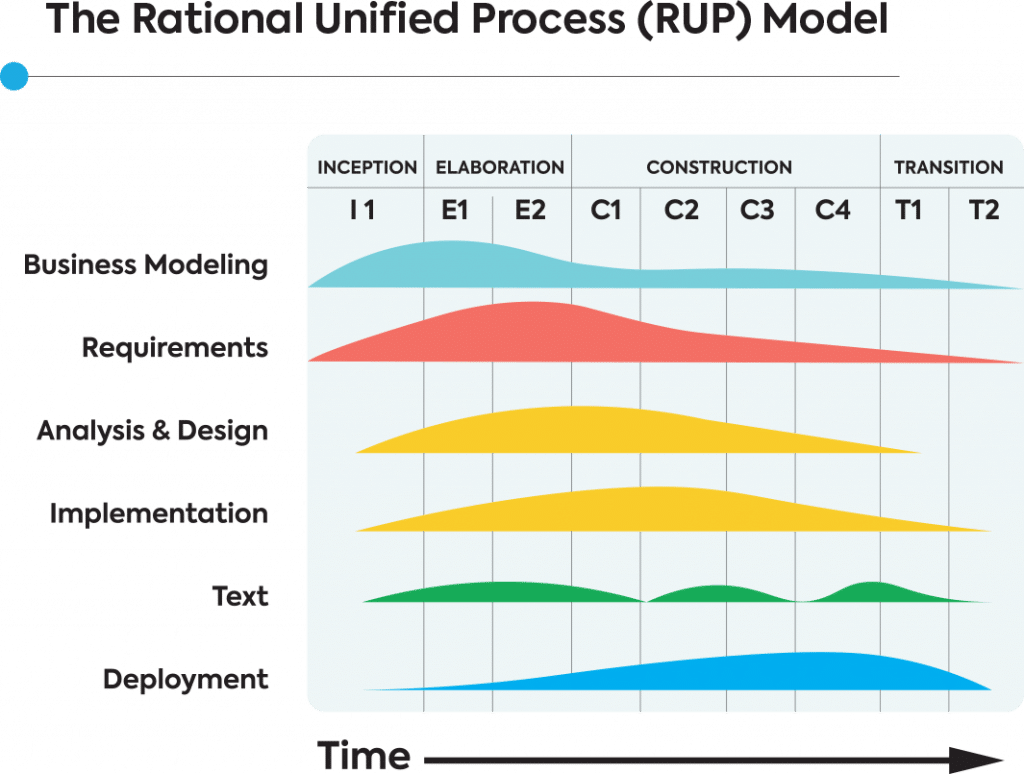
Each of the project steps is present at every phase.
Depending on the project timeline, the degree of focus on a particular step will vary. Within the elaboration, construction, and transition phases, it is common to work on more than one iteration.
Although this software delivery model is both flexible and great at reducing risk, it is also a very complex methodology to implement. You will need a team of highly experienced developers who know how to manage this model with confidence. Even then, you won’t get the same degree of flexibility as you would with a more agile approach.
Prototype Model
As the name indicates, the Prototyping model is all about researching, testing, evaluating, and enhancing.
Prototyping is a hybrid of the Waterfall model that pays close attention to client and user feedback. First, the requirements are set and developers will work on a prototype. Users then test the samples and provide feedback. After revisiting the initial requirements, developers will start programming the product.

By heavily involving your users in the process, the end product is much more likely to meet expectations. However, the Prototyping model is not without its complications. It is extremely difficult to anticipate the iterations needed until the prototype has been created. Therefore, costs can be unpredictable, and progress slow.
Extreme Programming (XP)
This agile framework is extremely flexible. Because of this, amendments can be made at numerous stages. Iterations generally occur in 1-2 week stints. Your involvement in the project is key to its success so that developers can implement your feedback almost instantly.

Like with most agile frameworks, extreme flexibility can be both a gift and a curse! Although handy for larger projects with unclear requirements, it can also complicate the sequential flow and prevent you from sticking to your initial timeline.
Lean Model
Lean is also an agile framework.
The methodology behind this approach is centered around feedback and optimization. Otherwise known as the Minimum Viable Product, developers analyze and plan the project thoroughly first to guarantee efficiency.
After discussing and optimizing the plan your team can create a very simple version of the software to get the ball rolling. User feedback and client input are of great importance in this model.
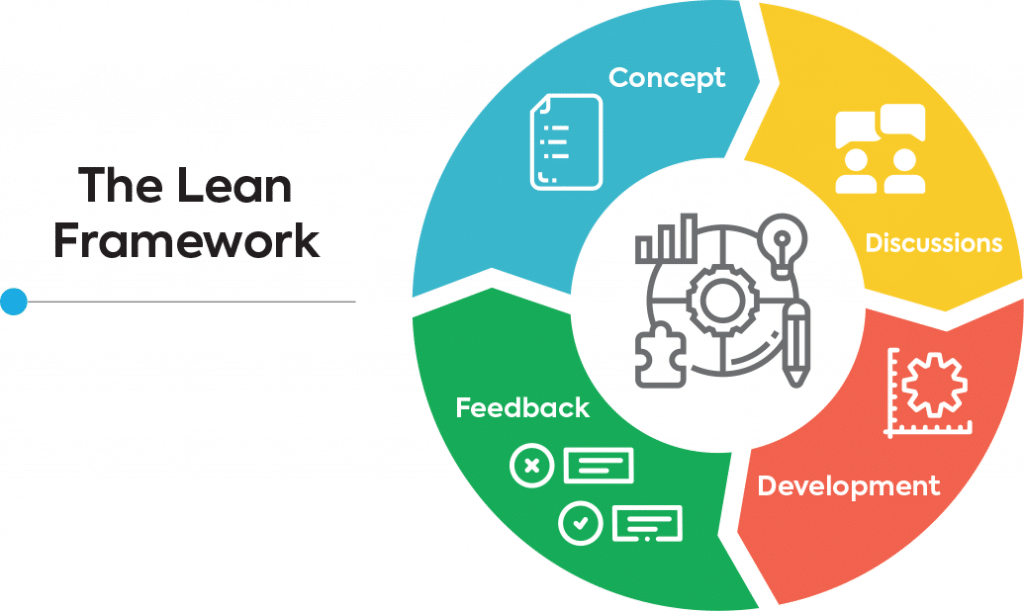
This framework is best for projects with a time limit and a tight budget to follow. Only choose this approach if you have the time needed to communicate regularly and be highly involved in feedback and decision making.
Dynamic Systems Model
Originally a software development model in its own rights, Dynamic Systems is now an agile framework.
Efficiency and cost are the driving forces of motivation for this method. In DSDM (Dynamic Systems Development Method), developers study the business requirements and level of flexibility in depth.
This makes for easier delivery of high-quality software, while still respecting the timeframe and budget set.
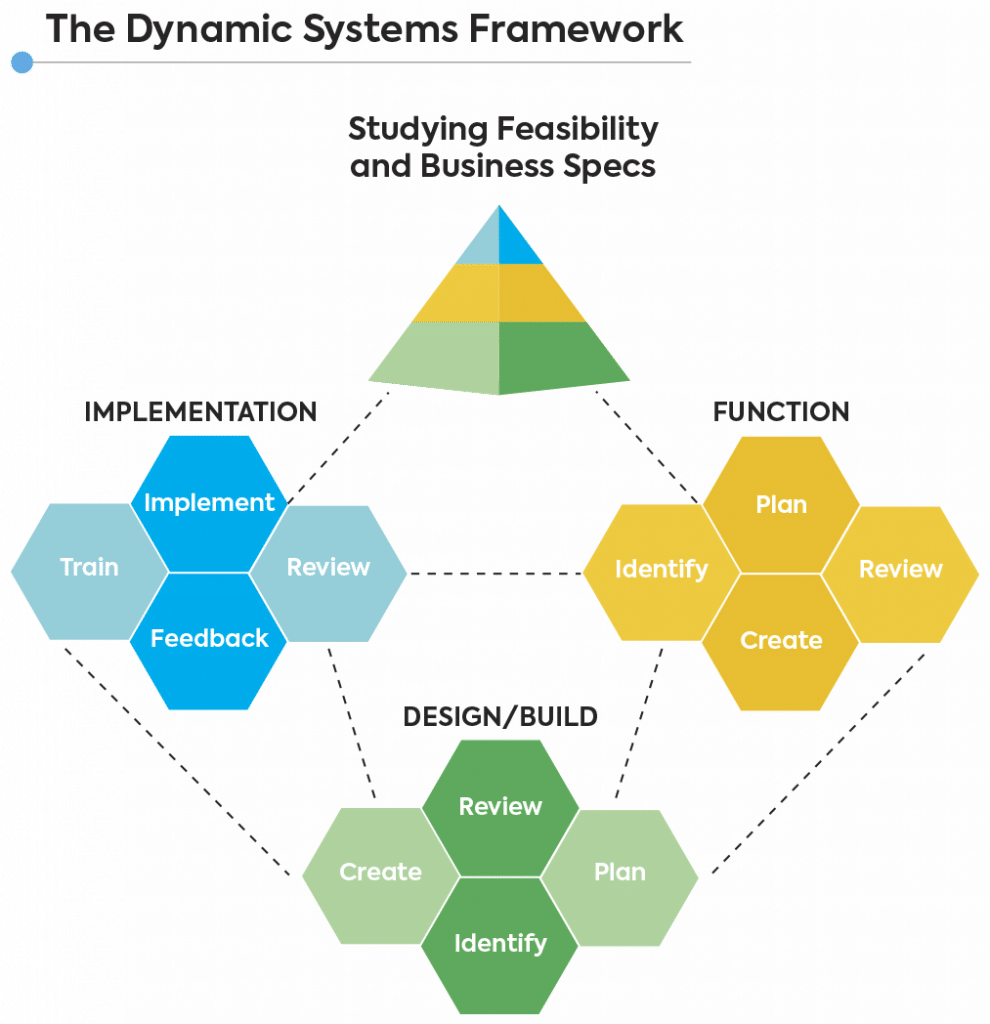
User feedback and regular communication are also key in this method. Present at every stage, expectations can be met to the highest standards and within a short timeframe. Having said this, it is a very costly software development process model to implement. We wouldn’t recommend the DSMD method for small and medium-sized software development projects.
Feature-driven Model
Feature-driven development (FDD for short) is also considered agile in its approach. Building upon the principles of successful development, FDD is feature and user-centric. Breaking the project up into features helps simplify complex processes, making it ideal for big teams and projects.
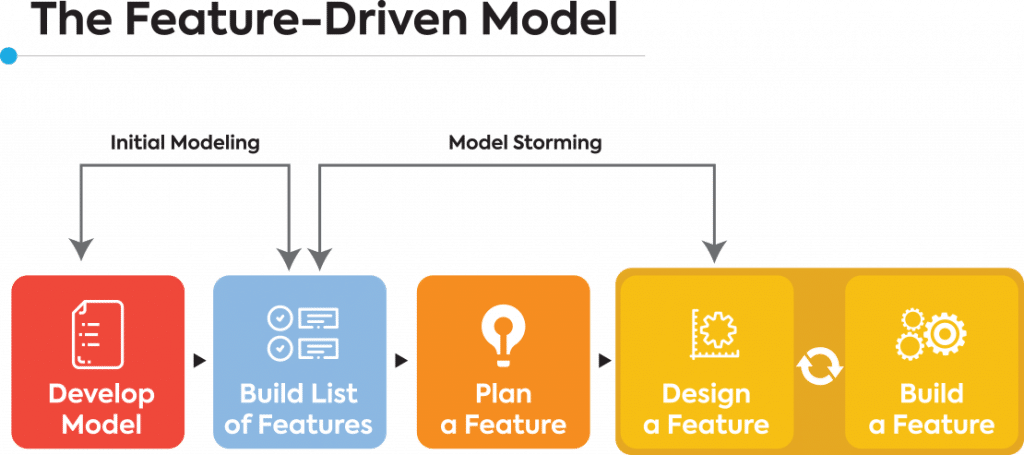
Although a great choice for larger companies, working to a set deadline can be a challenge. It is also not a good fit for smaller development teams and projects.
Joint Application Development Model
Joint application development (otherwise known as JAD) is an SDLC methodology that shares similar principles to the agile model.
In this software development process, clients and developers interact frequently to ensure the end results exceed expectations. One of the characteristic traits of JAD is collaborative sessions.
In these workshops stakeholders, users, and experts meet to discuss the software development project in detail.
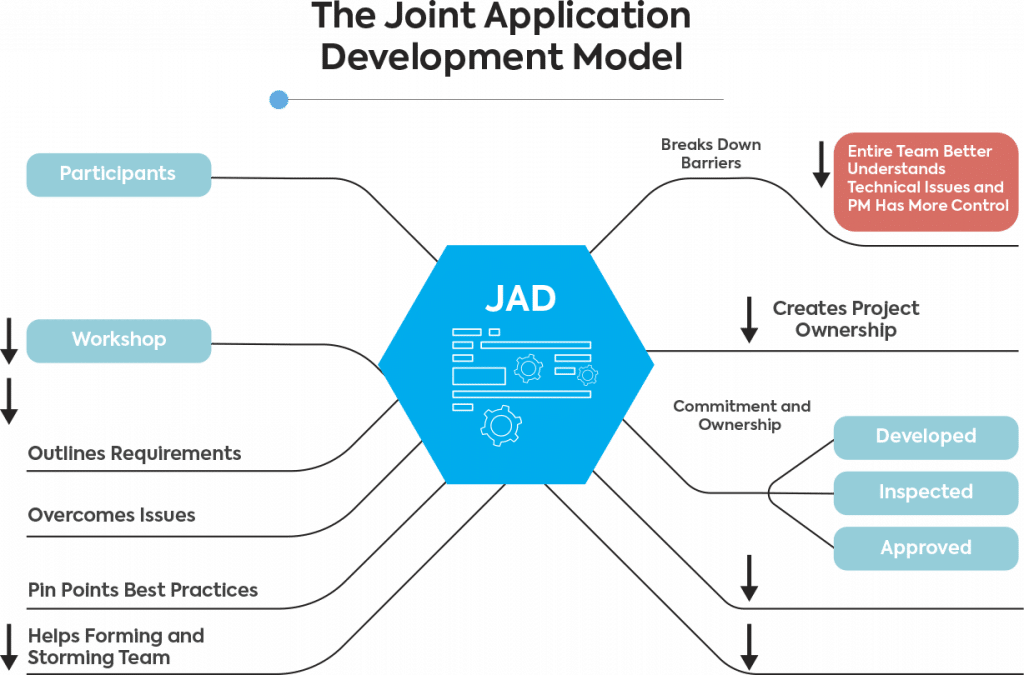
The collaborative nature of this model can help identify errors early on and resolve them before the mistakes become too costly to fix.
However, so much interaction and communication come at a high price.
Only the most experienced developers can work on this kind of project. This makes it more expensive than alternative methods. The process can also be very time-consuming.
Only turn to this type of software development methodology if you have the time and energy to be heavily involved in the project.
Cracking the Code — Finding the Right
Software
Development Life Cycle
Models for you
There are many misconceptions surrounding the SDLC models.
Uncovering the truth and making informed decisions will be crucial to your success. You need to evaluate the benefits and drawbacks of each software development model from within the context of your specific business requirements.
The average cost of developing software is around $36,000 but ranges anywhere from $3000 to $120,000.
you’re willing to invest in your ideas, make sure you know what’s best for you. Consult a reliable expert who can advise you on the different life cycle methodologies most suited to your project.
Turning your ideas into concrete deliverables that inspire, takes knowledge, time, and money. Understanding the truth about each model will help you to make the right choices.
Common Misconceptions
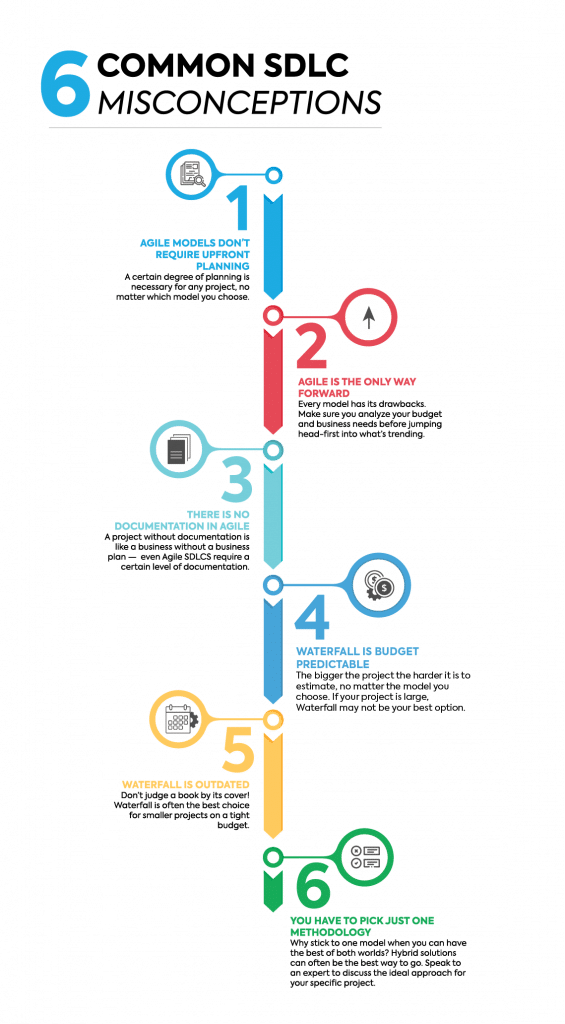 Some of the most common misconceptions to keep in mind before making your final decision, include:
Some of the most common misconceptions to keep in mind before making your final decision, include:
- Agile software engineering models
don’t require any upfront planning! This simply isn’t true. You still need to do some planning upfront to clarify details that you will be working on 10 sprints from now. If you don’t, you run the risk of making architectural decisions that lead to disjointed software. So if you want to go agile because it means jumping into the action from day one, you’ll be disappointed. A certain degree of planning will still be necessary if your project is to be successful.
-
Agile is the only way forward Agile is extremely popular, but it is not without its drawbacks. For one, it is often more expensive than alternative methods. So before diving into the latest agile trend, make sure you analyze your budget and business needs against the advantages and disadvantages of this model.
-
There is no documentation in Agile Again, this is not true. Often, writing documents is part of each sprint. A project without any documentation would lead to great complications further down the line.
-
Waterfall is outdated There are certainly downsides to waterfall, but it is often the best choice for smaller projects with tight budgets. So don’t rule it out as being old-fashioned until you have a clearer idea of what can and can’t be done using this
software development process model
.
-
Waterfall is budget predictable The bigger the project, the harder it is to estimate. Waterfall is the easiest model to predict and set fixed budgets, but that doesn’t mean it is perfect. It is almost impossible to anticipate the bugs you might find at the end of the process. For larger projects, these bugs can be expensive to fix. So if your software idea is big, Waterfall is unlikely to be your best choice.
-
You have to pick just one methodology This isn’t true. Depending on your project needs, hybrid solutions are often the way to go. They can give you the flexibility to create a killer combination. For example, you could have a Waterfall methodology overall and then use agile frameworks to include two-month sprints of work. Doing this could help you reach internal milestones. This is just one hybrid example — there are many others too. If you work with the right professionals, the software world is your oyster!
Final Thoughts
Making an informed decision before getting started cannot be underestimated.
The Standish Group found that the average time for “failed” projects” was 222% of the original estimate. But failure should not be an option.
Your ideas deserve your attention.
They are ready and waiting to transform into reality.
The question is, do you have the support you need to see your project through to success?











